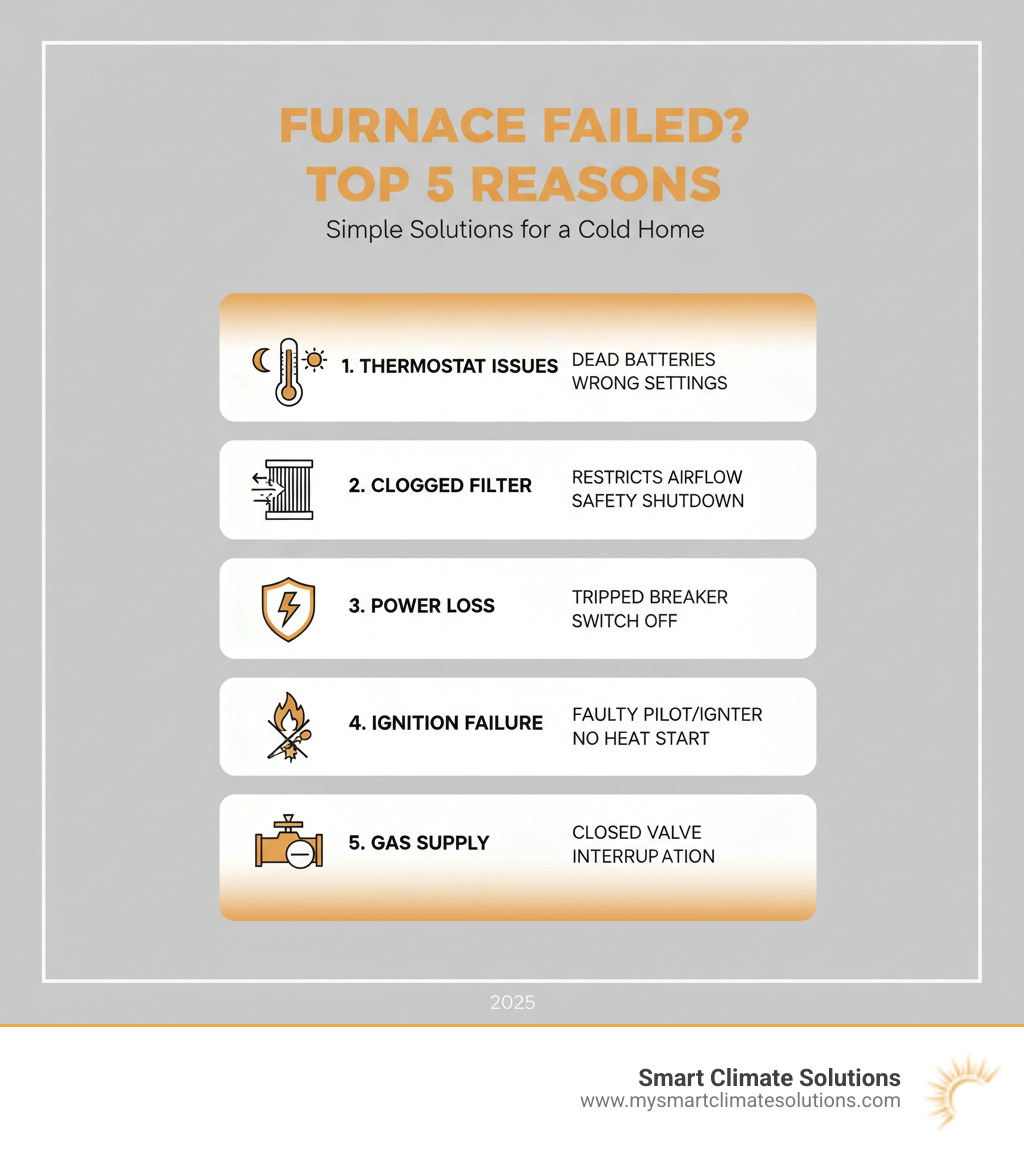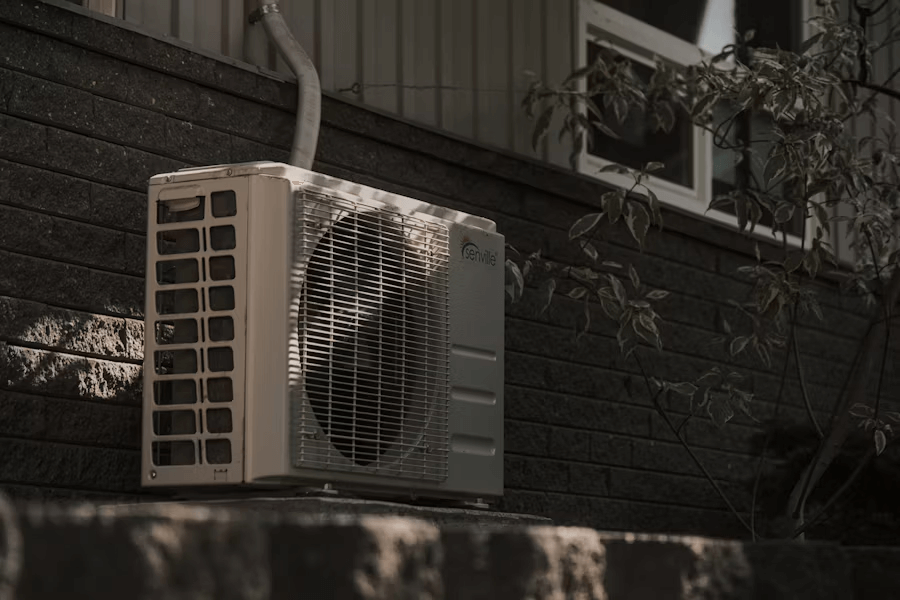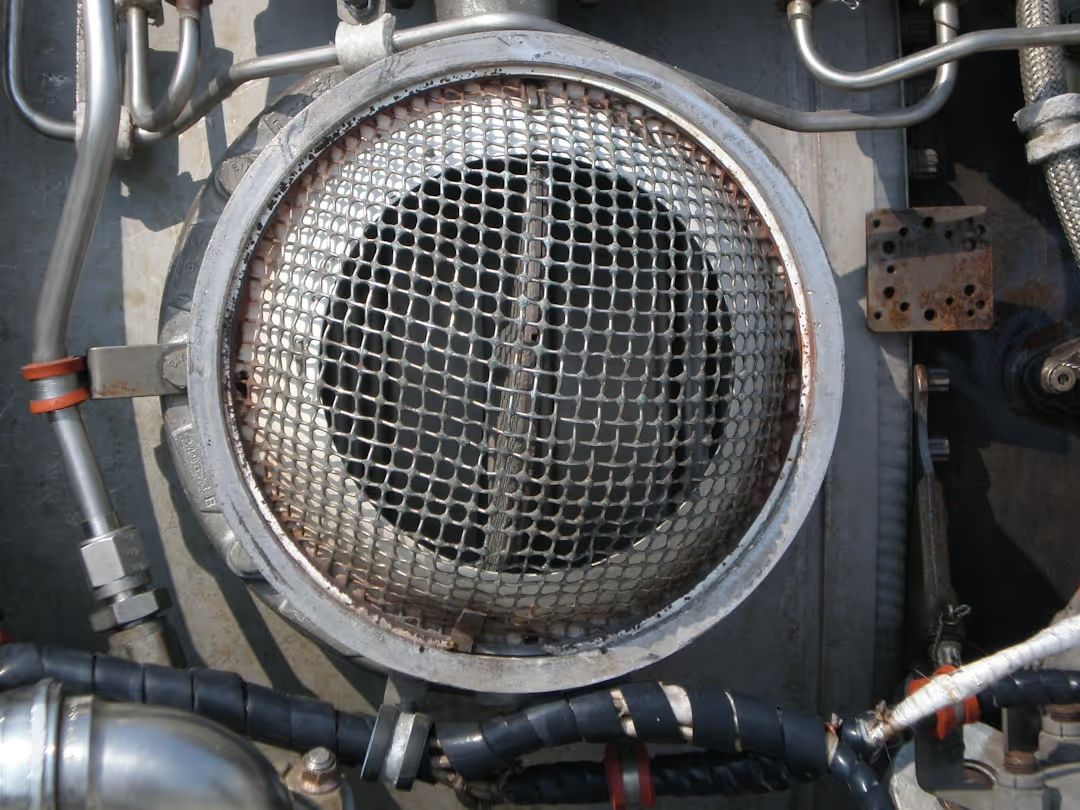When Your Furnace Fails: What to Do First
When your furnace stopped working on a cold Pittsburgh morning, panic can set in. You're not alone; this is a common issue for homeowners, especially during brutal winter cold snaps that test our heating systems.
Quick troubleshooting steps when your furnace won't start:
- Check your thermostat - Ensure it's set to 'Heat' and the temperature is above room temperature.
- Replace thermostat batteries - Dead batteries are a common culprit.
- Verify power supply - Check the furnace switch and circuit breaker.
- Inspect the air filter - A clogged filter can shut down your system.
- Look for error lights - Many furnaces display diagnostic codes.
The good news is that many furnace problems have simple solutions you can handle yourself. Basic thermostat checks alone can prevent about 25% of service calls. However, some issues, like gas leaks or carbon monoxide risks, require immediate professional attention.
This guide walks you through safe, step-by-step troubleshooting. We'll also cover critical safety warnings and when to call for help.
I'm Bill Scott, general manager of Smart Climate Solutions. With over 15 years in the HVAC industry, I've helped thousands of Pittsburgh homeowners with furnace stopped working emergencies. Knowing what to check first can save you time, money, and a cold night.

Simple furnace stopped working glossary:
First Steps: Simple Checks You Can Do in 5 Minutes
When you realize your furnace stopped working, don't panic. Before imagining expensive repairs, let's do some quick detective work. At Smart Climate Solutions, we find that about 40% of 'no heat' calls are simple fixes homeowners can do themselves, usually involving the thermostat or power supply.
These quick checks are the most common solutions when a heating system goes silent. For more comprehensive troubleshooting, check out our detailed guide on heating system not working.
How to Check Your Thermostat
Your thermostat is the brain of your heating system, and problems here are often the easiest to fix. Here's what to check:
- Display and Batteries: Is the display blank or dim? It's likely dead batteries. Replacing them fixes many heating emergencies, even on hardwired thermostats that use batteries for backup.
- Mode Setting: Ensure it's set to 'HEAT', not 'COOL' or 'OFF'. This is a common mistake during fluctuating spring and fall weather.
- Temperature Setting: Set the temperature at least 5 degrees higher than the current room temperature to call for heat.
- Fan Setting: The fan should be on 'AUTO', not 'ON'. The 'ON' setting runs the fan constantly without producing heat, while 'AUTO' only runs it during a heating cycle.
- Smart Thermostat: If you have a smart thermostat, try rebooting it. Sometimes a simple restart is all it needs.
Checking the Power Supply
Gas furnaces need electricity for their controls. If your furnace stopped working and has no signs of life, it's likely a power issue.
- Furnace Power Switch: Find the power switch, which looks like a light switch, near your furnace. Ensure it's in the 'ON' position. It's often flipped off by accident.
- Circuit Breaker: If the switch is on, check your circuit breaker panel for a breaker labeled 'FURNACE,' 'HVAC,' or 'HEATER.' A tripped breaker will be in the middle or 'OFF' position.
- Resetting the Breaker: To reset it, push the breaker firmly to 'OFF,' then back to 'ON.' If it trips again immediately, stop. This indicates a larger problem that needs a professional.
A pro tip for Pittsburgh homeowners: breakers often trip during power outages or storms, which are common in our winters. If these simple checks don't solve the problem, we'll move on to more complex issues.
Common Culprits When Your Furnace Stopped Working
If you've checked the thermostat and power but are still cold, it's time to look at the mechanical heart of your system. When a furnace stopped working, the issue often lies with one of a few key components responsible for creating and distributing heat.
A Clogged Air Filter is a Frequent Cause of a Furnace that Stopped Working
A clogged air filter is one of the most common and easily fixed reasons a furnace stopped working. A dirty filter restricts airflow, forcing your furnace to work harder. This can cause the system to overheat, triggering a safety limit switch that shuts the furnace down to prevent damage.
To check your filter, find the rectangular panel near the blower or return air duct. Slide it out and hold it to a light; if you can't see light through it, it needs replacing.
We recommend Pittsburgh homeowners check filters monthly and replace them every 1-3 months. If you have pets or allergies, monthly changes are best. Stick to the MERV rating recommended by your furnace manufacturer, as higher-rated filters can restrict airflow too much.
For more complex fan issues, learn about the cost to replace a furnace fan on our blog.
Pilot Light or Igniter Failure
The pilot light or igniter is what starts the flame in your furnace. If it fails, your furnace stopped working because it can't ignite the gas.
- Older Furnaces (Standing Pilot Light): These have a small, continuous flame that can go out due to drafts or dirt. Relighting instructions are usually on a label inside the furnace panel. If you're not comfortable following them, call a professional.
- Modern Furnaces (Electronic Ignition): These use a hot surface igniter (which glows red-hot) or an intermittent pilot. A faulty igniter may have visible cracks or chips, or it may not glow when the furnace tries to start. Replacing these delicate parts is often a job for a pro.
For detailed repair cost information, see our guide on the cost to fix a furnace ignitor.
Dirty Burners or Blocked Vents
Dirty burners or blocked vents can prevent your furnace from heating effectively, even if it ignites. This can make it seem like your furnace stopped working at full capacity.
- Dirty Burners: Over time, burners collect dust and rust. The key sign is the flame color. A healthy flame is steady and blue. Yellow or flickering flames indicate incomplete combustion, which is inefficient and a potential safety issue. While cleaning burners is a DIY possibility for some, we often recommend professional service.
- Blocked Vents: Check all supply and return vents in your home. Make sure they aren't blocked by furniture, rugs, or other items. Also, ensure the area around the furnace unit itself is clear for at least 6 feet to allow for proper airflow.
Safety First: Critical Warnings and When to Call a Pro
While some DIY troubleshooting is fine when your furnace stopped working, safety must be your top priority. Certain warning signs demand immediate professional attention and can prevent serious danger to your home and family.
Knowing the line between a simple fix and a dangerous repair is crucial. Prioritizing your family's safety is always the smartest choice.
What to Do if Your Furnace Stopped Working and You Smell Gas
If you smell gas (a 'rotten egg' odor) near your furnace or in your home, it is a life-threatening emergency. Follow these steps immediately:
- Evacuate Everyone: Get all people and pets out of the house immediately.
- Don't Touch Electronics: Do not use light switches, phones, or any appliances. A tiny spark can ignite the gas.
- Call for Help: From a safe location (like a neighbor's home or outside), call your gas company's emergency line and 911.
- Stay Outside: Do not re-enter your home until emergency responders say it is safe.
Gas leaks must be handled by your utility company first. For furnace issues after the gas is cleared, Smart Climate Solutions provides 24/7 furnace repair.
Recognizing Carbon Monoxide Dangers
Carbon monoxide (CO) is a colorless, odorless, and deadly gas that can be produced by a malfunctioning furnace. It's impossible to detect without a CO detector.
Symptoms of CO poisoning mimic the flu: headaches, dizziness, nausea, and fatigue. If multiple family members feel sick, especially when the furnace is running, get to fresh air immediately and seek medical attention.
Your best defense is a working CO detector. Install detectors on every level of your home, particularly near sleeping areas. Test them monthly and replace batteries yearly.
A cracked heat exchanger or a yellow (not blue) pilot light are signs your furnace could be producing CO. These issues require immediate professional inspection.
Signs You Need Immediate Professional Help
Some problems are not safe for DIY repair and require a certified technician. Call a professional if you notice:
- Repeatedly Tripping Breaker: This signals a serious electrical fault that could be a fire hazard. Do not keep resetting it.
- Loud Noises: Banging, grinding, or hissing sounds indicate mechanical failure, combustion problems, or potential leaks.
- Water Pooling: Water around the furnace can point to clogged drain lines or other leaks that can cause damage and mold.
- Burning Smells: Odors of burning plastic or metal suggest overheating components and a fire risk.
- Troubleshooting Fails: If you've tried the basic steps and your furnace stopped working or still won't heat, it's time for an expert with diagnostic tools.
For these issues, contact Smart Climate Solutions. Our certified technicians can safely handle complex furnace problems. Our furnace repair Pittsburgh guide offers more local resources.
What to Do While Waiting for a Technician
If your furnace stopped working and you're waiting for a technician from Smart Climate Solutions, there are temporary measures you can take. Especially during a Pittsburgh cold snap, these steps can protect your home from damage and keep your family more comfortable until we arrive.
These are not permanent fixes, but they can help you manage until we restore your heat.
Preventing Frozen Pipes
When your furnace stopped working in a Pittsburgh winter, your biggest threat is frozen pipes, which can burst and cause major water damage. Here's how to prevent them:
- Let Faucets Drip: Allow a slow, steady drip from faucets, especially on exterior walls. Moving water is less likely to freeze.
- Open Cabinet Doors: Open cabinets under sinks to let warmer room air circulate around pipes.
- Circulate Air: Use fans to move air around your home. If possible, set your thermostat's fan to 'ON' to circulate residual warm air.
- Insulate Exposed Pipes: Wrap any exposed pipes in your basement or crawl space with towels or blankets for temporary insulation.
Staying Warm Safely
Staying warm without a furnace requires a focus on safety. Avoid dangerous heating practices.
- Dress in Layers: Multiple thin layers trap body heat more effectively than one thick one.
- Use Space Heaters Safely: This is critical. Plug heaters directly into a wall outlet, not an extension cord. Keep them at least three feet from anything flammable (curtains, furniture, bedding) and never leave them unattended. Space heaters are a major cause of house fires.
- Conserve Heat: Close doors to unused rooms to concentrate heat in one or two main living areas.
- Avoid Unsafe Methods: Never use your oven for long-term heating due to fire and carbon monoxide risks. It should only be a last resort for short periods with proper ventilation.
These temporary measures will help you stay safe and warm until our technician arrives.
Preventative Maintenance to Avoid Future Breakdowns
An ounce of prevention is worth a pound of cure, especially for your furnace. While troubleshooting is useful when your furnace stopped working, proactive maintenance is the best way to avoid emergencies.
Regular care can extend your furnace's lifespan beyond the typical 15-20 years, lower energy bills, and prevent breakdowns. At Smart Climate Solutions, we've seen Pittsburgh homeowners save money and avoid stress with basic maintenance. Catching small issues early prevents them from becoming expensive problems. Learn more about our HVAC tune up specials.
The Importance of an Annual Furnace Tune Up
An annual furnace tune-up is like a physical for your heating system, catching problems before they lead to costly repairs or a no-heat emergency.
During a professional tune-up, a certified technician will:
- Clean Internal Components: Thoroughly clean burners, the heat exchanger, and the blower assembly to improve efficiency and safety.
- Lubricate Moving Parts: Proper lubrication of motors and bearings prevents premature wear and tear.
- Perform Safety Checks: Inspect for gas leaks, test the heat exchanger for cracks, and verify all safety controls are working correctly. This is the most critical part of the service.
Catching issues early saves money on repairs and lowers energy bills by ensuring your furnace runs efficiently. The cost of annual maintenance is a small price to pay compared to an emergency repair. Ready to give your furnace the care it deserves? You can easily schedule a furnace tune up with our team today.
Simple Homeowner Maintenance
Between professional tune-ups, you can perform simple tasks to reduce the risk of your furnace stopped working.
- Replace Your Air Filter: This is the most important task. Check it monthly and replace it every 1-3 months.
- Clear Outdoor Vents: Keep intake and exhaust vents free of snow, leaves, and debris, especially after Pittsburgh snowstorms.
- Keep the Furnace Area Clear: Maintain at least 6 feet of clear space around your furnace to ensure proper airflow and prevent fire hazards.
- Change Thermostat Batteries: If your thermostat uses batteries, change them annually to prevent unexpected shutdowns.
These simple steps, combined with an annual professional tune-up, are your best defense against heating emergencies.
Conclusion
When your furnace stopped working on a cold Pittsburgh morning, it's a familiar, sinking feeling. But as this guide shows, many failures have simple solutions. Checking your thermostat, power supply, and air filter can often solve the problem without a service call.
We've also covered mechanical culprits like a pilot light issue, a faulty igniter, or dirty burners. Understanding these helps you know when to call a technician.
Most importantly, safety always comes first. If you smell gas, evacuate immediately and call for help from a safe location. The same applies to any symptoms of carbon monoxide exposure. These are not DIY situations.
At Smart Climate Solutions, we've helped Pittsburgh area families with heating emergencies for over 15 years. Our certified technicians serve Pittsburgh, South Hills, Burgettstown, Washington PA, Steubenville OH, St. Clairsville OH, and Weirton WV. A furnace stopped working emergency doesn't keep business hours, which is why we offer 24/7 support.
Breakdowns often happen during the worst cold snaps. That's when you need fast, reliable service. Our team is equipped to handle any furnace failure.
Don't shiver through another night worrying about frozen pipes. Whether you need an emergency repair or want to schedule preventive maintenance, we're here to help. Contact us today for expert HVAC service and repair and restore your home's comfort.








.png)
